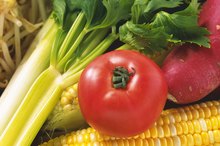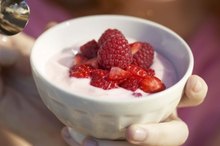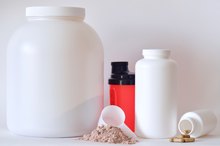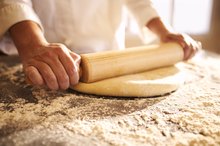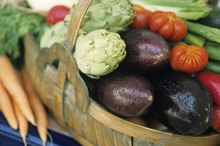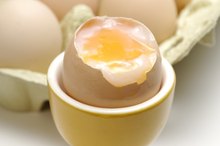Yeast, Gluten and Dairy Free Diets
Your diet can play a major role in your overall health, especially if you suffer from food allergies or certain medical conditions that may affect your digestive tract. Gluten-, yeast-, and dairy-free diets all provide specific results designed to treat different health disorders. Following a diet that restricts certain substances may help improve your condition and minimize digestive discomfort.
Gluten-Free Diet
The main purpose of a gluten-free diet is to treat a condition known as celiac disease. This disease causes irritation and inflammation within your small intestines. Gluten is a type of protein that exists naturally in foods that contain grain products, such as barley, rye and wheat. This diet requires avoiding obvious sources of gluten, including graham flour, matzo meal, semolina and bulgur. Purchasing products that specify they are gluten-free will help you avoid these less obvious sources of gluten. Cornmeal, rice, tapioca and polenta are grain products that don’t contain gluten and are suitable ingredients to include in a gluten-free diet.
- The main purpose of a gluten-free diet is to treat a condition known as celiac disease.
- Cornmeal, rice, tapioca and polenta are grain products that don’t contain gluten and are suitable ingredients to include in a gluten-free diet.
Yeast-Free Diet
Special K Diet Side Effects
Learn More
A healthy digestive system contains a balance of yeast and bacteria. Candida albicans is a type of yeast that lives in damp areas of your body, such as your intestines, skin folds and vagina. Taking antibiotics may reduce the bacteria that keep yeast growth in check, leading to an abundance of candida. A yeast-free diet eliminates certain foods, such as beer and cheese, while increasing the intake of foods that may reduce yeast, such as garlic and barberry. Taking probiotics, such as acidophilus and bifidus, may help keep yeast growth within healthy limits, according to New York University Langone Medical Center 1.
- A healthy digestive system contains a balance of yeast and bacteria.
- Taking probiotics, such as acidophilus and bifidus, may help keep yeast growth within healthy limits, according to New York University Langone Medical Center 1.
Dairy-Free Diet
Although most people can eat dairy products without any negative effects, people with lactose intolerance often require a dairy-free, or lactose-free, diet 3. Lactose is a natural sugar in milk, butter, cream, yogurt and cheese. Other products that may contain lactose include certain baked goods, salad dressings, margarines and shortenings. Eliminating lactose from your diet can help reduce uncomfortable symptoms, such as diarrhea, cramping and gas 3. Lactose-free dairy products are suitable for consumption 3.
Precautions
Candida Diet & Soy
Learn More
Avoid making major changes to your diet without first consulting your doctor, especially if you have a chronic illness or medical condition. When eliminating certain food substances, make healthy substitutions to ensure you consume adequate amounts of important nutrients. Prolonged and recurrent digestive disorders may signal the presence of an underlying medical condition that requires medical treatment.
Related Articles
References
- New York University Langone Medical Center: Candida/Yeast Hypersensitivity Syndrome
- Children's Digestive Health and Nutrition Foundation: Gluten-Free Diet Guide for Families
- Drugs.com: Lactose Free Diet
- US National Library of Medicine. Lactose intolerance. Medline Plus. 2019.
- National Institutes of Health. Lactose Intolerance. Genetics Home Reference. 2019.
- Borghini R, Donato G, Alvaro D, Picarelli A. New insights in IBS-like disorders: Pandora's box has been opened; a review. Gastroenterol Hepatol Bed Bench. 2017;10(2):79-89.
- Szilagyi A, Ishayek N. Lactose intolerance, dairy avoidance, and treatment options. Nutrients. 2018;10(12). doi:10.3390/nu10121994
- Johns Hopkins Medicine. Lactose intolerance.
- KidsHealth from Nemours. Lactose intolerance. 2015.
- UW Integrative Health. The elimination diet. School of Medicine and Public Health University of Wisconsin Madison.
- Dekker PJT, Koenders D, Bruins MJ. Lactose-free dairy products: Market developments, production, nutrition and health benefits. Nutrients. 2019;11(3). doi:10.3390/nu11030551
- Cleveland Clinic. Gas: management and treatment. 2016.
- Ferreira-lazarte A, Moreno FJ, Villamiel M. Application of a commercial digestive supplement formulated with enzymes and probiotics in lactase non-persistence management. Food Funct. 2018;9(9):4642-4650. doi:10.1039/c8fo01091a
- Ferreira-Lazarte A , Moreno FJ , Villamiel M .Application of a commercial digestive supplement formulated with enzymes and probiotics in lactase non-persistence management.Food Funct. 2018 Sep 19;9(9):4642-4650. doi: 10.1039/c8fo01091a.
- Varjú P, Gede N, Szakács Z, Hegyi P, Cazacu IM, Pécsi D et al. Lactose intolerance but not lactose maldigestion is more frequent in patients with irritable bowel syndrome than in healthy controls: A meta-analysis.Neurogastroenterol Motil. 2019 May;31(5):e13527. doi: 10.1111/nmo.13527. Epub 2018 Dec 17.
Resources
Writer Bio
Laura Wallace Henderson, a professional freelance writer, began writing in 1989. Her articles appear online at Biz Mojo, Walden University and various other websites. She has served as the co-editor for "Kansas Women: Focus on Health." She continues to empower and encourage women everywhere by promoting health, career growth and business management skills.
